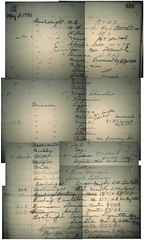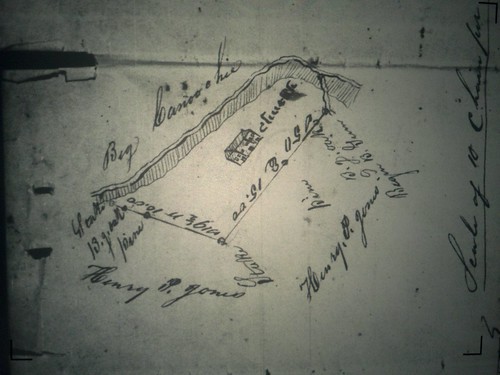The film I received was Minutes and Membership Lists, 1842-1859 for Hawhammock Missionary Baptist Church in Swainsboro, Emanuel, Georgia. I know that multiple generations of my paternal grandmother's family attended this church. I was hoping to find mention of deaths, baptisms and perhaps births and weddings in this film.
I didn't end up finding everything I was looking for, in part because the title of the film is misleading. It should be "partial" or "fragmented" Minutes and Membership Lists - because that's exactly what they are. At times 10 to 20 years were missing from the minutes. This was unfortunate, because the minutes did in fact include obituaries and baptisms, as well as other religious events. Of course, most of the years I needed were the ones that were missing.
 I did find a few things of interest however, including a membership list from 1938 which listed my Great-Grandmother (click the image on the right to see a bigger image). Her name, Ledora Britt, is crossed out and marked "dead," though no date is given.
I did find a few things of interest however, including a membership list from 1938 which listed my Great-Grandmother (click the image on the right to see a bigger image). Her name, Ledora Britt, is crossed out and marked "dead," though no date is given.And you'll notice that the image has been stitched together from multiple images. I don't know if it was the older machines (hand crank) or the film, but I couldn't zoom out far enough to see the entire width of the image. I ended up taking multiple pictures of the screen and stitching them together.
And while I was waiting on this film to arrive, I discovered that the Georgia Archive has a copy (c'mon GA-A, index your film on something more hi-tech than a physical card catalogue!). I'll be back there again on Thursday, so I'll take a look at this film on a newer machine and see if I can get a better view. Also, I'll be able to save to flash drive there.
I have two more films coming in soon, so I'll see how that experience goes before deciding to order any more film.


2 comments:
GREAT blog posting!
Most Family History Centers microfilm readers with different lenses -- one more highly magnifies, and is particularly useful for 16MM microfilm.
Also the lens on the reader printer, and on the scanner is newer technology, and you may be able to do better there as well.
I am thrilled that on your first film you found something useful.
Ordering microfilm of original parish registers is how I managed to do much England and Germany research from a distance.
I agree that seeing what's on the next two films is wise before ordering more... not because the microfilm records aren't a good resource.
It is just that INFO contained on those microfilms may lead you down a different research path.
They say it's all on the internet, but whomever "they" are -- they just aren't well informed.
The Family History Library in Salt Lake City, Utah has records from over 120 countries throughout the world. And you've discovered the miracle of being able to order most of those records in through your local Family History Center.
It will take FamilySearch years to work through the old microfilm contracts with archives, churches and courthouses, in order to obtain rights to digitally reproduce those films and make things available on the Internet.
Keep up the good work!
StImaging product also provides the ease of use of a standard motorized film carrier about Microfilm Scanners.
Post a Comment